NRS93004: Reflection on Motivational Interviewing in Practice
VerifiedAdded on 2023/06/04
|9
|2471
|242
Report
AI Summary
This report is a reflection on motivational interviewing (MI) techniques, based on a simulated interview. The author, a student, analyzes the interviewer's performance, highlighting strengths such as the client-centered approach and the use of a guiding style, while also identifying areas for improvement like the righting reflex and encouraging client confidence. The report discusses key MI principles, including ambivalence, listening, and encouraging change, and how they were applied in the interview. The author also examines the client's behavior, particularly their ambivalence towards substance abuse and work, and suggests further sessions with greater empathy and persuasive communication. The conclusion emphasizes the effectiveness of MI for addressing substance abuse and behavioral issues, emphasizing the need for future sessions focusing on empathy and genuine concern to help the client achieve their goals. The report references relevant literature and provides a comprehensive analysis of the interview, offering valuable insights into the practical application of MI in a mental health context.
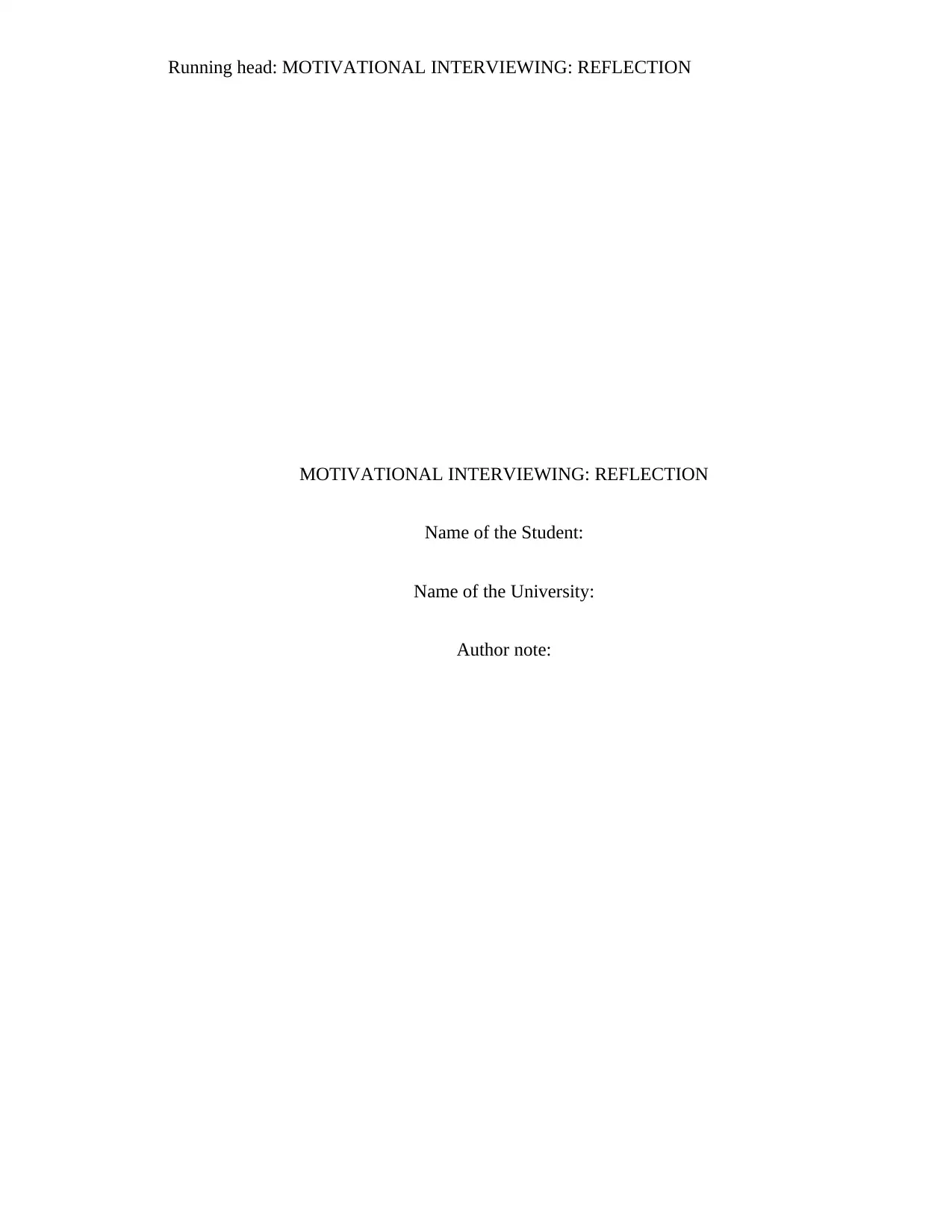
Running head: MOTIVATIONAL INTERVIEWING: REFLECTION
MOTIVATIONAL INTERVIEWING: REFLECTION
Name of the Student:
Name of the University:
Author note:
MOTIVATIONAL INTERVIEWING: REFLECTION
Name of the Student:
Name of the University:
Author note:
Paraphrase This Document
Need a fresh take? Get an instant paraphrase of this document with our AI Paraphraser
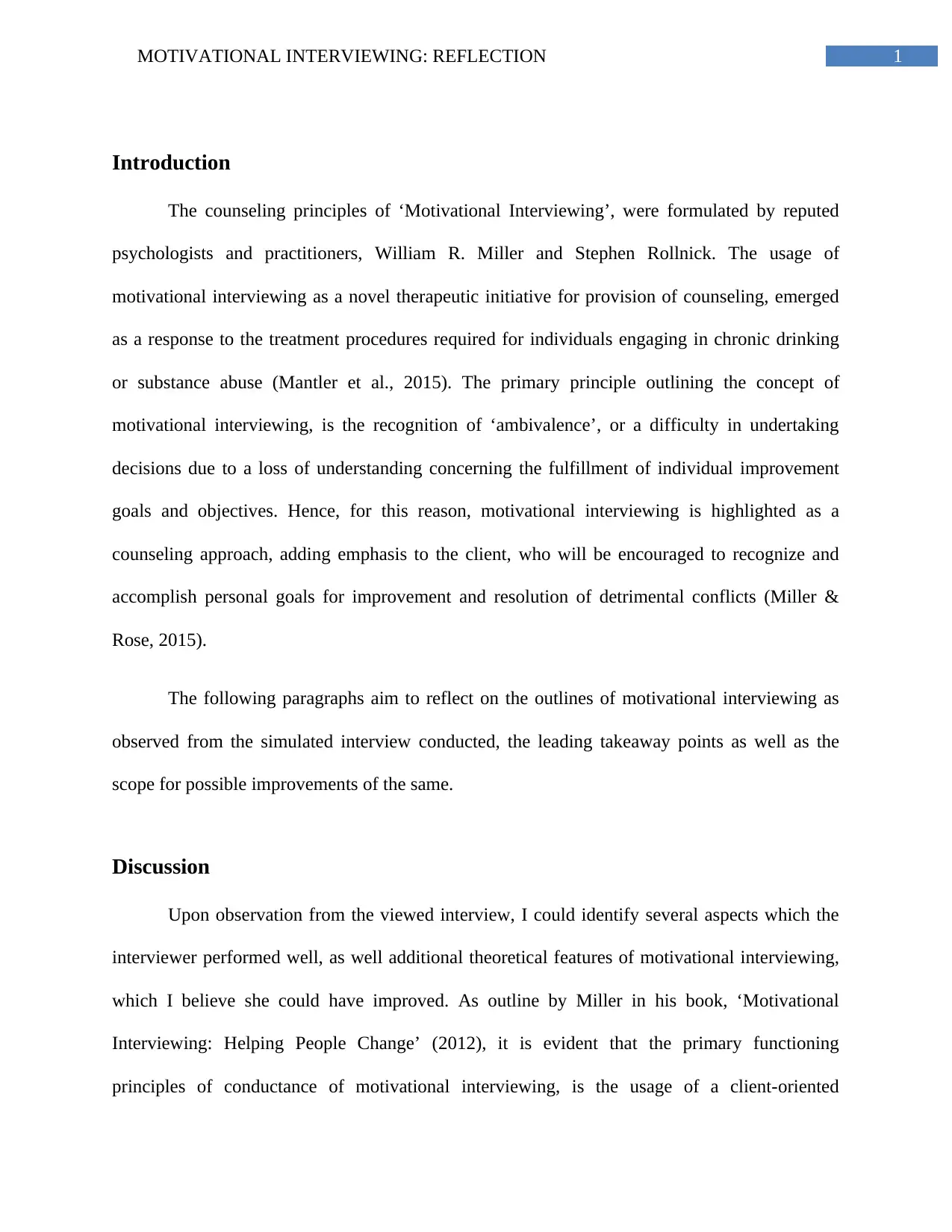
1MOTIVATIONAL INTERVIEWING: REFLECTION
Introduction
The counseling principles of ‘Motivational Interviewing’, were formulated by reputed
psychologists and practitioners, William R. Miller and Stephen Rollnick. The usage of
motivational interviewing as a novel therapeutic initiative for provision of counseling, emerged
as a response to the treatment procedures required for individuals engaging in chronic drinking
or substance abuse (Mantler et al., 2015). The primary principle outlining the concept of
motivational interviewing, is the recognition of ‘ambivalence’, or a difficulty in undertaking
decisions due to a loss of understanding concerning the fulfillment of individual improvement
goals and objectives. Hence, for this reason, motivational interviewing is highlighted as a
counseling approach, adding emphasis to the client, who will be encouraged to recognize and
accomplish personal goals for improvement and resolution of detrimental conflicts (Miller &
Rose, 2015).
The following paragraphs aim to reflect on the outlines of motivational interviewing as
observed from the simulated interview conducted, the leading takeaway points as well as the
scope for possible improvements of the same.
Discussion
Upon observation from the viewed interview, I could identify several aspects which the
interviewer performed well, as well additional theoretical features of motivational interviewing,
which I believe she could have improved. As outline by Miller in his book, ‘Motivational
Interviewing: Helping People Change’ (2012), it is evident that the primary functioning
principles of conductance of motivational interviewing, is the usage of a client-oriented
Introduction
The counseling principles of ‘Motivational Interviewing’, were formulated by reputed
psychologists and practitioners, William R. Miller and Stephen Rollnick. The usage of
motivational interviewing as a novel therapeutic initiative for provision of counseling, emerged
as a response to the treatment procedures required for individuals engaging in chronic drinking
or substance abuse (Mantler et al., 2015). The primary principle outlining the concept of
motivational interviewing, is the recognition of ‘ambivalence’, or a difficulty in undertaking
decisions due to a loss of understanding concerning the fulfillment of individual improvement
goals and objectives. Hence, for this reason, motivational interviewing is highlighted as a
counseling approach, adding emphasis to the client, who will be encouraged to recognize and
accomplish personal goals for improvement and resolution of detrimental conflicts (Miller &
Rose, 2015).
The following paragraphs aim to reflect on the outlines of motivational interviewing as
observed from the simulated interview conducted, the leading takeaway points as well as the
scope for possible improvements of the same.
Discussion
Upon observation from the viewed interview, I could identify several aspects which the
interviewer performed well, as well additional theoretical features of motivational interviewing,
which I believe she could have improved. As outline by Miller in his book, ‘Motivational
Interviewing: Helping People Change’ (2012), it is evident that the primary functioning
principles of conductance of motivational interviewing, is the usage of a client-oriented
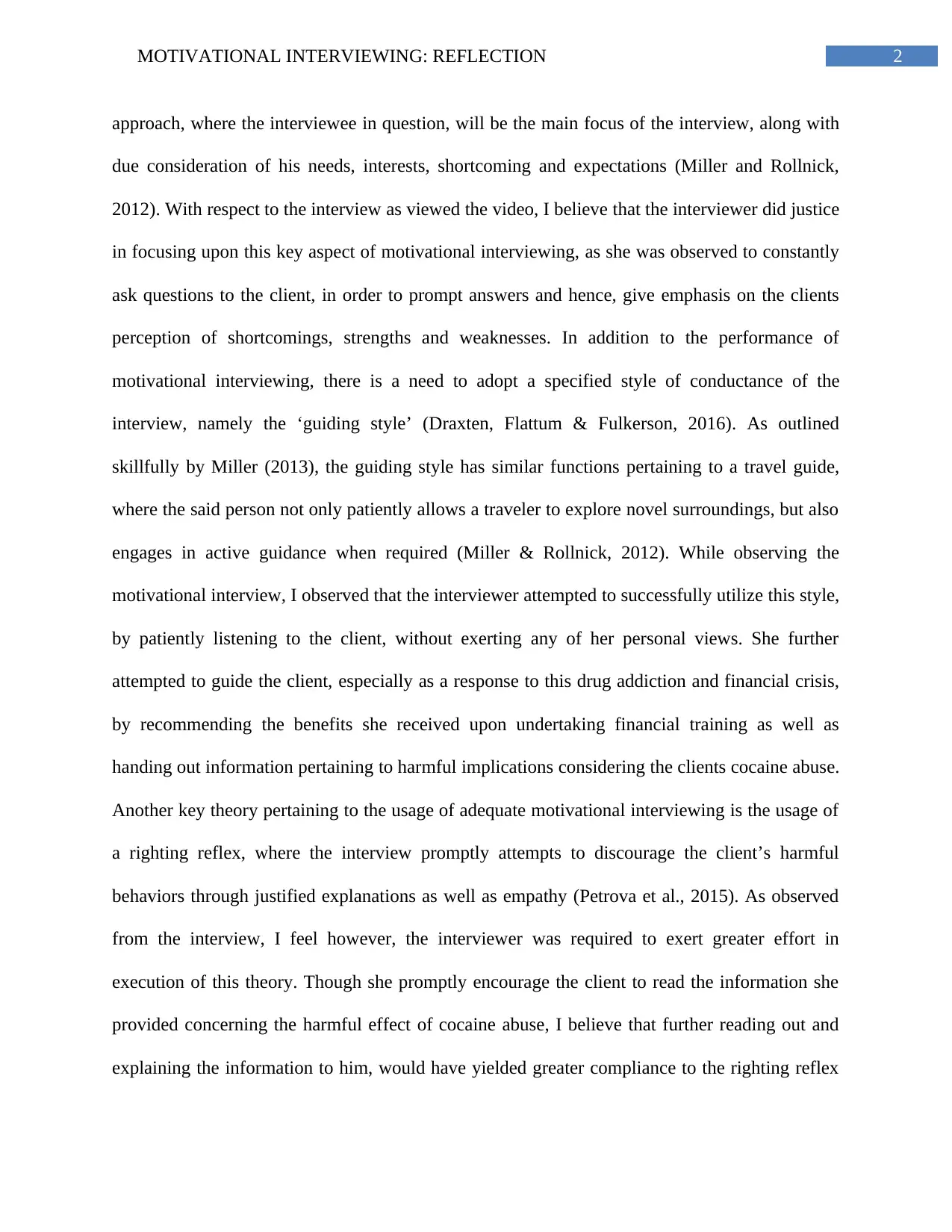
2MOTIVATIONAL INTERVIEWING: REFLECTION
approach, where the interviewee in question, will be the main focus of the interview, along with
due consideration of his needs, interests, shortcoming and expectations (Miller and Rollnick,
2012). With respect to the interview as viewed the video, I believe that the interviewer did justice
in focusing upon this key aspect of motivational interviewing, as she was observed to constantly
ask questions to the client, in order to prompt answers and hence, give emphasis on the clients
perception of shortcomings, strengths and weaknesses. In addition to the performance of
motivational interviewing, there is a need to adopt a specified style of conductance of the
interview, namely the ‘guiding style’ (Draxten, Flattum & Fulkerson, 2016). As outlined
skillfully by Miller (2013), the guiding style has similar functions pertaining to a travel guide,
where the said person not only patiently allows a traveler to explore novel surroundings, but also
engages in active guidance when required (Miller & Rollnick, 2012). While observing the
motivational interview, I observed that the interviewer attempted to successfully utilize this style,
by patiently listening to the client, without exerting any of her personal views. She further
attempted to guide the client, especially as a response to this drug addiction and financial crisis,
by recommending the benefits she received upon undertaking financial training as well as
handing out information pertaining to harmful implications considering the clients cocaine abuse.
Another key theory pertaining to the usage of adequate motivational interviewing is the usage of
a righting reflex, where the interview promptly attempts to discourage the client’s harmful
behaviors through justified explanations as well as empathy (Petrova et al., 2015). As observed
from the interview, I feel however, the interviewer was required to exert greater effort in
execution of this theory. Though she promptly encourage the client to read the information she
provided concerning the harmful effect of cocaine abuse, I believe that further reading out and
explaining the information to him, would have yielded greater compliance to the righting reflex
approach, where the interviewee in question, will be the main focus of the interview, along with
due consideration of his needs, interests, shortcoming and expectations (Miller and Rollnick,
2012). With respect to the interview as viewed the video, I believe that the interviewer did justice
in focusing upon this key aspect of motivational interviewing, as she was observed to constantly
ask questions to the client, in order to prompt answers and hence, give emphasis on the clients
perception of shortcomings, strengths and weaknesses. In addition to the performance of
motivational interviewing, there is a need to adopt a specified style of conductance of the
interview, namely the ‘guiding style’ (Draxten, Flattum & Fulkerson, 2016). As outlined
skillfully by Miller (2013), the guiding style has similar functions pertaining to a travel guide,
where the said person not only patiently allows a traveler to explore novel surroundings, but also
engages in active guidance when required (Miller & Rollnick, 2012). While observing the
motivational interview, I observed that the interviewer attempted to successfully utilize this style,
by patiently listening to the client, without exerting any of her personal views. She further
attempted to guide the client, especially as a response to this drug addiction and financial crisis,
by recommending the benefits she received upon undertaking financial training as well as
handing out information pertaining to harmful implications considering the clients cocaine abuse.
Another key theory pertaining to the usage of adequate motivational interviewing is the usage of
a righting reflex, where the interview promptly attempts to discourage the client’s harmful
behaviors through justified explanations as well as empathy (Petrova et al., 2015). As observed
from the interview, I feel however, the interviewer was required to exert greater effort in
execution of this theory. Though she promptly encourage the client to read the information she
provided concerning the harmful effect of cocaine abuse, I believe that further reading out and
explaining the information to him, would have yielded greater compliance to the righting reflex
⊘ This is a preview!⊘
Do you want full access?
Subscribe today to unlock all pages.

Trusted by 1+ million students worldwide
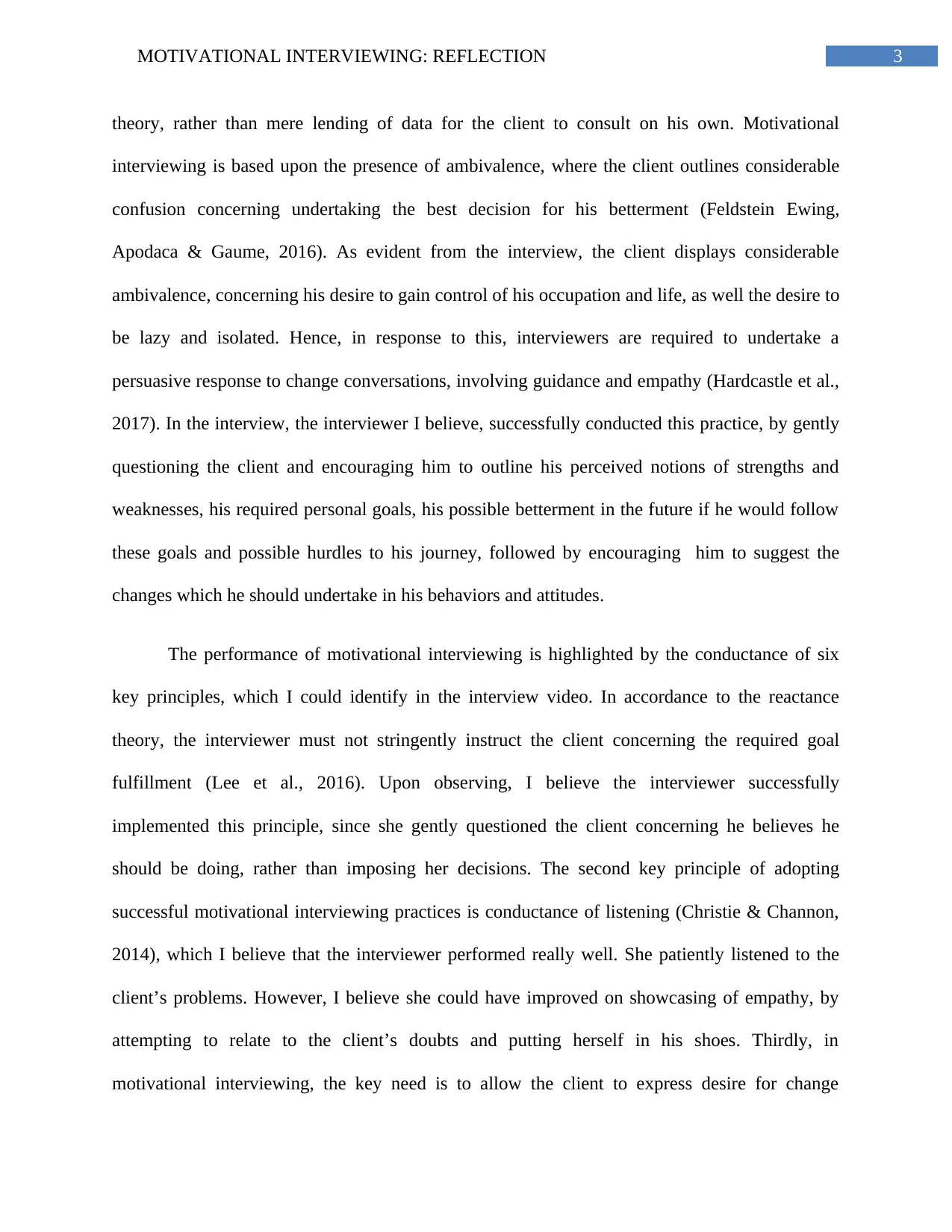
3MOTIVATIONAL INTERVIEWING: REFLECTION
theory, rather than mere lending of data for the client to consult on his own. Motivational
interviewing is based upon the presence of ambivalence, where the client outlines considerable
confusion concerning undertaking the best decision for his betterment (Feldstein Ewing,
Apodaca & Gaume, 2016). As evident from the interview, the client displays considerable
ambivalence, concerning his desire to gain control of his occupation and life, as well the desire to
be lazy and isolated. Hence, in response to this, interviewers are required to undertake a
persuasive response to change conversations, involving guidance and empathy (Hardcastle et al.,
2017). In the interview, the interviewer I believe, successfully conducted this practice, by gently
questioning the client and encouraging him to outline his perceived notions of strengths and
weaknesses, his required personal goals, his possible betterment in the future if he would follow
these goals and possible hurdles to his journey, followed by encouraging him to suggest the
changes which he should undertake in his behaviors and attitudes.
The performance of motivational interviewing is highlighted by the conductance of six
key principles, which I could identify in the interview video. In accordance to the reactance
theory, the interviewer must not stringently instruct the client concerning the required goal
fulfillment (Lee et al., 2016). Upon observing, I believe the interviewer successfully
implemented this principle, since she gently questioned the client concerning he believes he
should be doing, rather than imposing her decisions. The second key principle of adopting
successful motivational interviewing practices is conductance of listening (Christie & Channon,
2014), which I believe that the interviewer performed really well. She patiently listened to the
client’s problems. However, I believe she could have improved on showcasing of empathy, by
attempting to relate to the client’s doubts and putting herself in his shoes. Thirdly, in
motivational interviewing, the key need is to allow the client to express desire for change
theory, rather than mere lending of data for the client to consult on his own. Motivational
interviewing is based upon the presence of ambivalence, where the client outlines considerable
confusion concerning undertaking the best decision for his betterment (Feldstein Ewing,
Apodaca & Gaume, 2016). As evident from the interview, the client displays considerable
ambivalence, concerning his desire to gain control of his occupation and life, as well the desire to
be lazy and isolated. Hence, in response to this, interviewers are required to undertake a
persuasive response to change conversations, involving guidance and empathy (Hardcastle et al.,
2017). In the interview, the interviewer I believe, successfully conducted this practice, by gently
questioning the client and encouraging him to outline his perceived notions of strengths and
weaknesses, his required personal goals, his possible betterment in the future if he would follow
these goals and possible hurdles to his journey, followed by encouraging him to suggest the
changes which he should undertake in his behaviors and attitudes.
The performance of motivational interviewing is highlighted by the conductance of six
key principles, which I could identify in the interview video. In accordance to the reactance
theory, the interviewer must not stringently instruct the client concerning the required goal
fulfillment (Lee et al., 2016). Upon observing, I believe the interviewer successfully
implemented this principle, since she gently questioned the client concerning he believes he
should be doing, rather than imposing her decisions. The second key principle of adopting
successful motivational interviewing practices is conductance of listening (Christie & Channon,
2014), which I believe that the interviewer performed really well. She patiently listened to the
client’s problems. However, I believe she could have improved on showcasing of empathy, by
attempting to relate to the client’s doubts and putting herself in his shoes. Thirdly, in
motivational interviewing, the key need is to allow the client to express desire for change
Paraphrase This Document
Need a fresh take? Get an instant paraphrase of this document with our AI Paraphraser
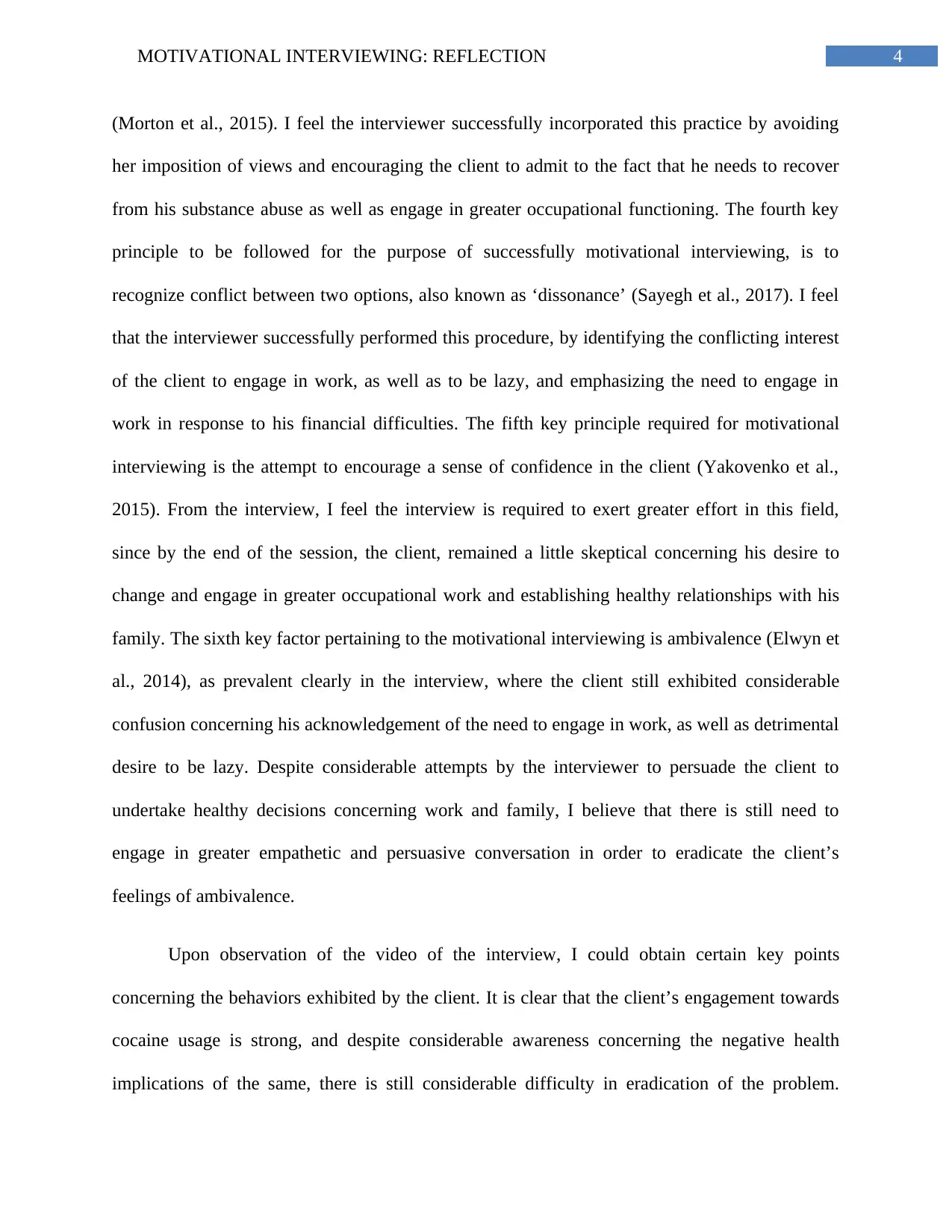
4MOTIVATIONAL INTERVIEWING: REFLECTION
(Morton et al., 2015). I feel the interviewer successfully incorporated this practice by avoiding
her imposition of views and encouraging the client to admit to the fact that he needs to recover
from his substance abuse as well as engage in greater occupational functioning. The fourth key
principle to be followed for the purpose of successfully motivational interviewing, is to
recognize conflict between two options, also known as ‘dissonance’ (Sayegh et al., 2017). I feel
that the interviewer successfully performed this procedure, by identifying the conflicting interest
of the client to engage in work, as well as to be lazy, and emphasizing the need to engage in
work in response to his financial difficulties. The fifth key principle required for motivational
interviewing is the attempt to encourage a sense of confidence in the client (Yakovenko et al.,
2015). From the interview, I feel the interview is required to exert greater effort in this field,
since by the end of the session, the client, remained a little skeptical concerning his desire to
change and engage in greater occupational work and establishing healthy relationships with his
family. The sixth key factor pertaining to the motivational interviewing is ambivalence (Elwyn et
al., 2014), as prevalent clearly in the interview, where the client still exhibited considerable
confusion concerning his acknowledgement of the need to engage in work, as well as detrimental
desire to be lazy. Despite considerable attempts by the interviewer to persuade the client to
undertake healthy decisions concerning work and family, I believe that there is still need to
engage in greater empathetic and persuasive conversation in order to eradicate the client’s
feelings of ambivalence.
Upon observation of the video of the interview, I could obtain certain key points
concerning the behaviors exhibited by the client. It is clear that the client’s engagement towards
cocaine usage is strong, and despite considerable awareness concerning the negative health
implications of the same, there is still considerable difficulty in eradication of the problem.
(Morton et al., 2015). I feel the interviewer successfully incorporated this practice by avoiding
her imposition of views and encouraging the client to admit to the fact that he needs to recover
from his substance abuse as well as engage in greater occupational functioning. The fourth key
principle to be followed for the purpose of successfully motivational interviewing, is to
recognize conflict between two options, also known as ‘dissonance’ (Sayegh et al., 2017). I feel
that the interviewer successfully performed this procedure, by identifying the conflicting interest
of the client to engage in work, as well as to be lazy, and emphasizing the need to engage in
work in response to his financial difficulties. The fifth key principle required for motivational
interviewing is the attempt to encourage a sense of confidence in the client (Yakovenko et al.,
2015). From the interview, I feel the interview is required to exert greater effort in this field,
since by the end of the session, the client, remained a little skeptical concerning his desire to
change and engage in greater occupational work and establishing healthy relationships with his
family. The sixth key factor pertaining to the motivational interviewing is ambivalence (Elwyn et
al., 2014), as prevalent clearly in the interview, where the client still exhibited considerable
confusion concerning his acknowledgement of the need to engage in work, as well as detrimental
desire to be lazy. Despite considerable attempts by the interviewer to persuade the client to
undertake healthy decisions concerning work and family, I believe that there is still need to
engage in greater empathetic and persuasive conversation in order to eradicate the client’s
feelings of ambivalence.
Upon observation of the video of the interview, I could obtain certain key points
concerning the behaviors exhibited by the client. It is clear that the client’s engagement towards
cocaine usage is strong, and despite considerable awareness concerning the negative health
implications of the same, there is still considerable difficulty in eradication of the problem.
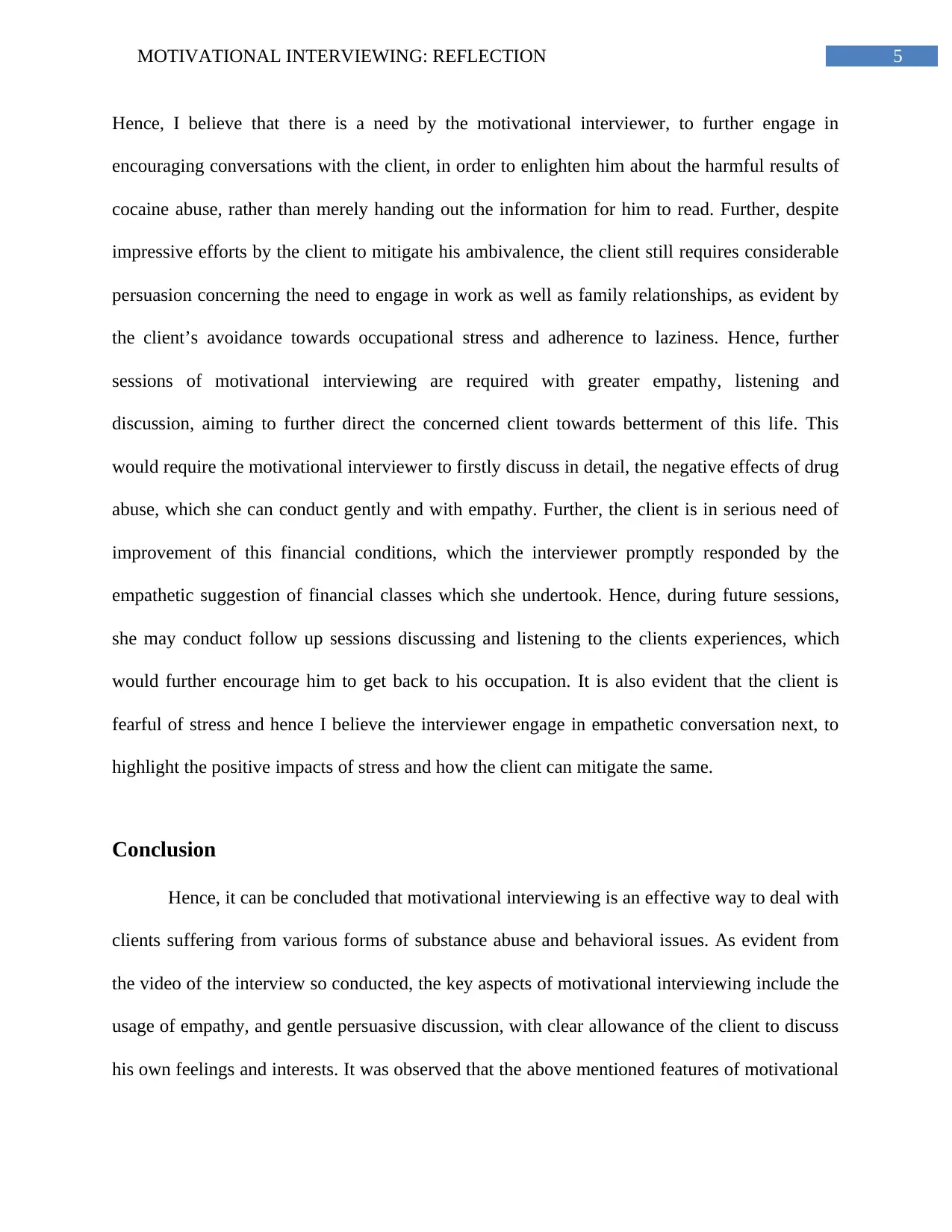
5MOTIVATIONAL INTERVIEWING: REFLECTION
Hence, I believe that there is a need by the motivational interviewer, to further engage in
encouraging conversations with the client, in order to enlighten him about the harmful results of
cocaine abuse, rather than merely handing out the information for him to read. Further, despite
impressive efforts by the client to mitigate his ambivalence, the client still requires considerable
persuasion concerning the need to engage in work as well as family relationships, as evident by
the client’s avoidance towards occupational stress and adherence to laziness. Hence, further
sessions of motivational interviewing are required with greater empathy, listening and
discussion, aiming to further direct the concerned client towards betterment of this life. This
would require the motivational interviewer to firstly discuss in detail, the negative effects of drug
abuse, which she can conduct gently and with empathy. Further, the client is in serious need of
improvement of this financial conditions, which the interviewer promptly responded by the
empathetic suggestion of financial classes which she undertook. Hence, during future sessions,
she may conduct follow up sessions discussing and listening to the clients experiences, which
would further encourage him to get back to his occupation. It is also evident that the client is
fearful of stress and hence I believe the interviewer engage in empathetic conversation next, to
highlight the positive impacts of stress and how the client can mitigate the same.
Conclusion
Hence, it can be concluded that motivational interviewing is an effective way to deal with
clients suffering from various forms of substance abuse and behavioral issues. As evident from
the video of the interview so conducted, the key aspects of motivational interviewing include the
usage of empathy, and gentle persuasive discussion, with clear allowance of the client to discuss
his own feelings and interests. It was observed that the above mentioned features of motivational
Hence, I believe that there is a need by the motivational interviewer, to further engage in
encouraging conversations with the client, in order to enlighten him about the harmful results of
cocaine abuse, rather than merely handing out the information for him to read. Further, despite
impressive efforts by the client to mitigate his ambivalence, the client still requires considerable
persuasion concerning the need to engage in work as well as family relationships, as evident by
the client’s avoidance towards occupational stress and adherence to laziness. Hence, further
sessions of motivational interviewing are required with greater empathy, listening and
discussion, aiming to further direct the concerned client towards betterment of this life. This
would require the motivational interviewer to firstly discuss in detail, the negative effects of drug
abuse, which she can conduct gently and with empathy. Further, the client is in serious need of
improvement of this financial conditions, which the interviewer promptly responded by the
empathetic suggestion of financial classes which she undertook. Hence, during future sessions,
she may conduct follow up sessions discussing and listening to the clients experiences, which
would further encourage him to get back to his occupation. It is also evident that the client is
fearful of stress and hence I believe the interviewer engage in empathetic conversation next, to
highlight the positive impacts of stress and how the client can mitigate the same.
Conclusion
Hence, it can be concluded that motivational interviewing is an effective way to deal with
clients suffering from various forms of substance abuse and behavioral issues. As evident from
the video of the interview so conducted, the key aspects of motivational interviewing include the
usage of empathy, and gentle persuasive discussion, with clear allowance of the client to discuss
his own feelings and interests. It was observed that the above mentioned features of motivational
⊘ This is a preview!⊘
Do you want full access?
Subscribe today to unlock all pages.

Trusted by 1+ million students worldwide
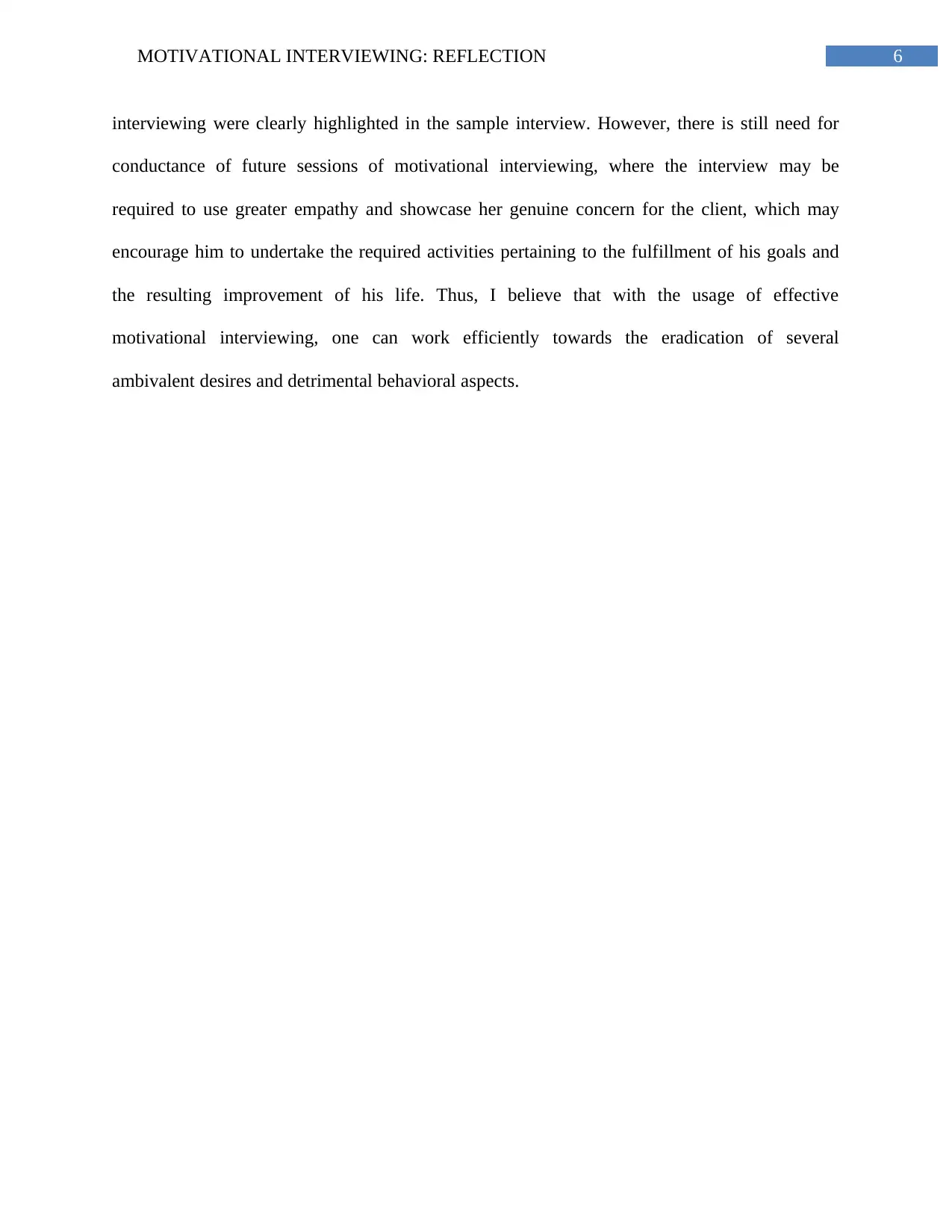
6MOTIVATIONAL INTERVIEWING: REFLECTION
interviewing were clearly highlighted in the sample interview. However, there is still need for
conductance of future sessions of motivational interviewing, where the interview may be
required to use greater empathy and showcase her genuine concern for the client, which may
encourage him to undertake the required activities pertaining to the fulfillment of his goals and
the resulting improvement of his life. Thus, I believe that with the usage of effective
motivational interviewing, one can work efficiently towards the eradication of several
ambivalent desires and detrimental behavioral aspects.
interviewing were clearly highlighted in the sample interview. However, there is still need for
conductance of future sessions of motivational interviewing, where the interview may be
required to use greater empathy and showcase her genuine concern for the client, which may
encourage him to undertake the required activities pertaining to the fulfillment of his goals and
the resulting improvement of his life. Thus, I believe that with the usage of effective
motivational interviewing, one can work efficiently towards the eradication of several
ambivalent desires and detrimental behavioral aspects.
Paraphrase This Document
Need a fresh take? Get an instant paraphrase of this document with our AI Paraphraser
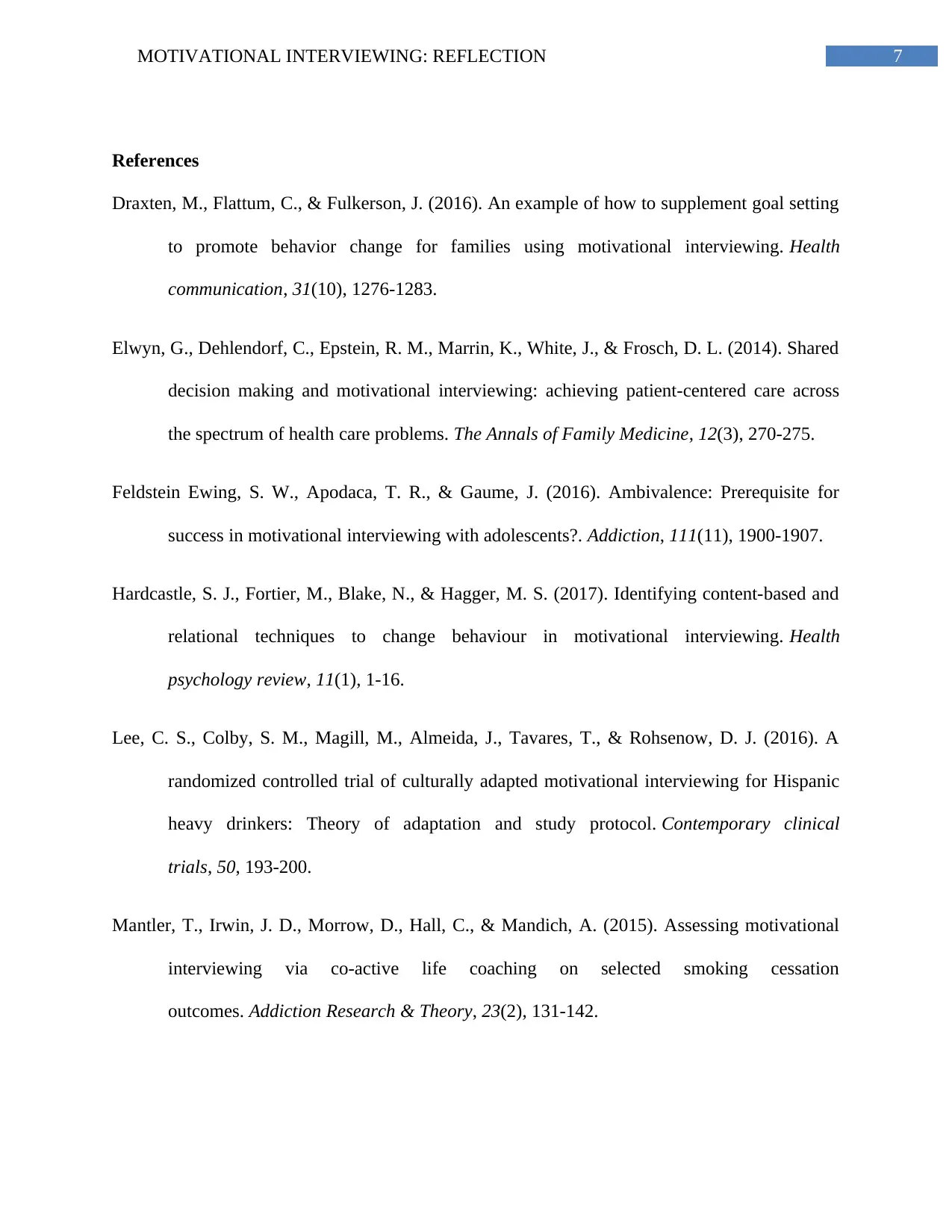
7MOTIVATIONAL INTERVIEWING: REFLECTION
References
Draxten, M., Flattum, C., & Fulkerson, J. (2016). An example of how to supplement goal setting
to promote behavior change for families using motivational interviewing. Health
communication, 31(10), 1276-1283.
Elwyn, G., Dehlendorf, C., Epstein, R. M., Marrin, K., White, J., & Frosch, D. L. (2014). Shared
decision making and motivational interviewing: achieving patient-centered care across
the spectrum of health care problems. The Annals of Family Medicine, 12(3), 270-275.
Feldstein Ewing, S. W., Apodaca, T. R., & Gaume, J. (2016). Ambivalence: Prerequisite for
success in motivational interviewing with adolescents?. Addiction, 111(11), 1900-1907.
Hardcastle, S. J., Fortier, M., Blake, N., & Hagger, M. S. (2017). Identifying content-based and
relational techniques to change behaviour in motivational interviewing. Health
psychology review, 11(1), 1-16.
Lee, C. S., Colby, S. M., Magill, M., Almeida, J., Tavares, T., & Rohsenow, D. J. (2016). A
randomized controlled trial of culturally adapted motivational interviewing for Hispanic
heavy drinkers: Theory of adaptation and study protocol. Contemporary clinical
trials, 50, 193-200.
Mantler, T., Irwin, J. D., Morrow, D., Hall, C., & Mandich, A. (2015). Assessing motivational
interviewing via co-active life coaching on selected smoking cessation
outcomes. Addiction Research & Theory, 23(2), 131-142.
References
Draxten, M., Flattum, C., & Fulkerson, J. (2016). An example of how to supplement goal setting
to promote behavior change for families using motivational interviewing. Health
communication, 31(10), 1276-1283.
Elwyn, G., Dehlendorf, C., Epstein, R. M., Marrin, K., White, J., & Frosch, D. L. (2014). Shared
decision making and motivational interviewing: achieving patient-centered care across
the spectrum of health care problems. The Annals of Family Medicine, 12(3), 270-275.
Feldstein Ewing, S. W., Apodaca, T. R., & Gaume, J. (2016). Ambivalence: Prerequisite for
success in motivational interviewing with adolescents?. Addiction, 111(11), 1900-1907.
Hardcastle, S. J., Fortier, M., Blake, N., & Hagger, M. S. (2017). Identifying content-based and
relational techniques to change behaviour in motivational interviewing. Health
psychology review, 11(1), 1-16.
Lee, C. S., Colby, S. M., Magill, M., Almeida, J., Tavares, T., & Rohsenow, D. J. (2016). A
randomized controlled trial of culturally adapted motivational interviewing for Hispanic
heavy drinkers: Theory of adaptation and study protocol. Contemporary clinical
trials, 50, 193-200.
Mantler, T., Irwin, J. D., Morrow, D., Hall, C., & Mandich, A. (2015). Assessing motivational
interviewing via co-active life coaching on selected smoking cessation
outcomes. Addiction Research & Theory, 23(2), 131-142.
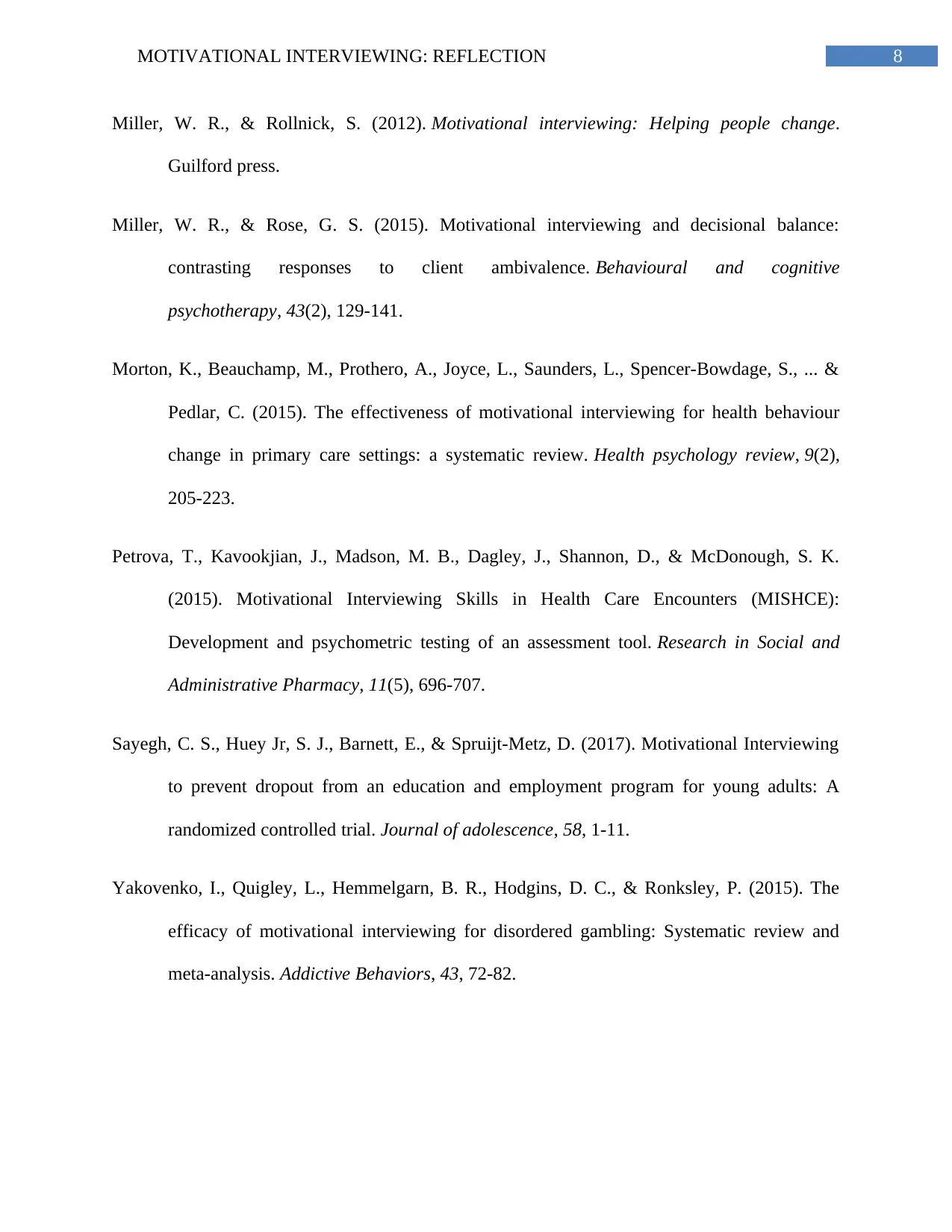
8MOTIVATIONAL INTERVIEWING: REFLECTION
Miller, W. R., & Rollnick, S. (2012). Motivational interviewing: Helping people change.
Guilford press.
Miller, W. R., & Rose, G. S. (2015). Motivational interviewing and decisional balance:
contrasting responses to client ambivalence. Behavioural and cognitive
psychotherapy, 43(2), 129-141.
Morton, K., Beauchamp, M., Prothero, A., Joyce, L., Saunders, L., Spencer-Bowdage, S., ... &
Pedlar, C. (2015). The effectiveness of motivational interviewing for health behaviour
change in primary care settings: a systematic review. Health psychology review, 9(2),
205-223.
Petrova, T., Kavookjian, J., Madson, M. B., Dagley, J., Shannon, D., & McDonough, S. K.
(2015). Motivational Interviewing Skills in Health Care Encounters (MISHCE):
Development and psychometric testing of an assessment tool. Research in Social and
Administrative Pharmacy, 11(5), 696-707.
Sayegh, C. S., Huey Jr, S. J., Barnett, E., & Spruijt-Metz, D. (2017). Motivational Interviewing
to prevent dropout from an education and employment program for young adults: A
randomized controlled trial. Journal of adolescence, 58, 1-11.
Yakovenko, I., Quigley, L., Hemmelgarn, B. R., Hodgins, D. C., & Ronksley, P. (2015). The
efficacy of motivational interviewing for disordered gambling: Systematic review and
meta-analysis. Addictive Behaviors, 43, 72-82.
Miller, W. R., & Rollnick, S. (2012). Motivational interviewing: Helping people change.
Guilford press.
Miller, W. R., & Rose, G. S. (2015). Motivational interviewing and decisional balance:
contrasting responses to client ambivalence. Behavioural and cognitive
psychotherapy, 43(2), 129-141.
Morton, K., Beauchamp, M., Prothero, A., Joyce, L., Saunders, L., Spencer-Bowdage, S., ... &
Pedlar, C. (2015). The effectiveness of motivational interviewing for health behaviour
change in primary care settings: a systematic review. Health psychology review, 9(2),
205-223.
Petrova, T., Kavookjian, J., Madson, M. B., Dagley, J., Shannon, D., & McDonough, S. K.
(2015). Motivational Interviewing Skills in Health Care Encounters (MISHCE):
Development and psychometric testing of an assessment tool. Research in Social and
Administrative Pharmacy, 11(5), 696-707.
Sayegh, C. S., Huey Jr, S. J., Barnett, E., & Spruijt-Metz, D. (2017). Motivational Interviewing
to prevent dropout from an education and employment program for young adults: A
randomized controlled trial. Journal of adolescence, 58, 1-11.
Yakovenko, I., Quigley, L., Hemmelgarn, B. R., Hodgins, D. C., & Ronksley, P. (2015). The
efficacy of motivational interviewing for disordered gambling: Systematic review and
meta-analysis. Addictive Behaviors, 43, 72-82.
⊘ This is a preview!⊘
Do you want full access?
Subscribe today to unlock all pages.

Trusted by 1+ million students worldwide
1 out of 9
Your All-in-One AI-Powered Toolkit for Academic Success.
+13062052269
info@desklib.com
Available 24*7 on WhatsApp / Email
![[object Object]](/_next/static/media/star-bottom.7253800d.svg)
Unlock your academic potential
Copyright © 2020–2025 A2Z Services. All Rights Reserved. Developed and managed by ZUCOL.
